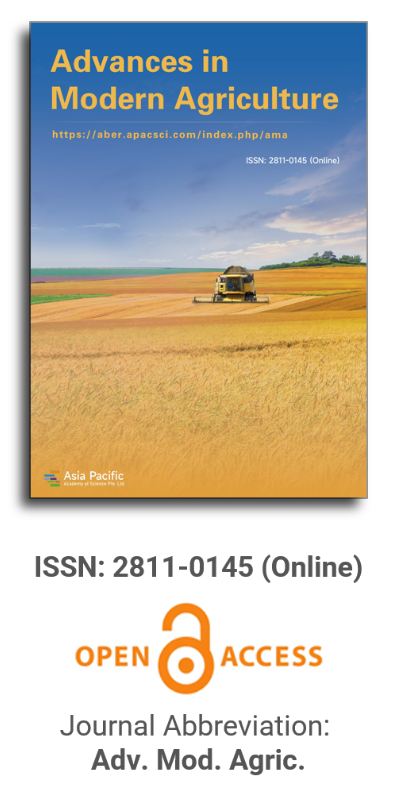


Eco-farming policies and sustainable food security in Qatar: The role of hydroponics
Vol 6, Issue 1, 2025
VIEWS - 1408 (Abstract)
Download PDF
Abstract
This article explores how hydroponics can help the State of Qatar implement sustainable agricultural policy in the face of the nation’s climatic and environmental problems, including a lack of arable land and water. Because it uses nutrient solutions to grow plants without soil, hydroponics is a cutting-edge substitute for conventional agriculture. It reduces water consumption and increases production efficiency. The article discusses how Qatar is adopting hydroponics within the framework of its National Vision 2023, which seeks to achieve food security by promoting innovation and sustainability in the agricultural sector. It also focuses on the environmental and economic benefits of hydroponics, such as reducing dependence on food imports and improving the use of natural resources by analysing available data. The article reviews the challenges of applying hydroponics in the State of Qatar, including the high initial cost and lack of public awareness. The article concludes that the demand for hydroponics in Qatar is rising due to a number of causes. Given Qatar’s harsh climate, hydroponics is a cutting-edge and environmentally friendly farming technique that enables year-round growing. Hydroponics is an effective method for growing crops, including fruits and vegetables, on a small amount of arable land and water.
Keywords
References
- Pawlak K, Kołodziejczak M. The Role of Agriculture in Ensuring Food Security in Developing Countries: Considerations in the Context of the Problem of Sustainable Food Production. Sustainability. 2020; 12(13): 5488. doi: 10.3390/su12135488
- Seppelt R, Klotz S, Peiter E, et al. Agriculture and food security under a changing climate: An underestimated challenge. iScience. 2022; 25(12): 105551. doi: 10.1016/j.isci.2022.105551
- Khouri N, Shideed K, Kherallah M. Food security: perspectives from the Arab World. Food Security. 2011; 3(S1): 1–6. doi: 10.1007/s12571-010-0101-4
- SESRI. (2021). Agricultural Census in the State of Qatar. Available online: https://www.mme.gov.qa/pdocs/cview?siteID=1&docID=24691&year=2022 (accessed on 5 May 2024).
- Fawwaz AA, Ahmed A. The Reality of Food Security in the Arab World. International Journal of Asian Social Science. 2016; 6(4): 251–261. doi: 10.18488/journal.1/2016.6.4/1.4.251.261
- Manikas I, Ali BM, Sundarakani B. A systematic literature review of indicators measuring food security. Agriculture & Food Security. 2023; 12(1). doi: 10.1186/s40066-023-00415-7
- Karanisa T, Amato A, Richer R, et al. Agricultural Production in Qatar’s Hot Arid Climate. Sustainability. 2021; 13(7): 4059. doi: 10.3390/su13074059
- Shomar B, Darwish M, Rowell C. What does Integrated Water Resources Management from Local to Global Perspective Mean? Qatar as a Case Study, the Very Rich Country with No Water. Water Resources Management. 2014; 28(10): 2781–2791. doi: 10.1007/s11269-014-0636-9
- Hassen T, El Bilali H. Sustainable Agriculture and Food Security in Qatar: International Threats and Local Constraints. In: Leal Filho W, Kovaleva M, Popkova E (editors). Sustainable Agriculture and Food Security. Springer International Publishing; 2022. pp. 425–442.
- Amhamed A, Genidi N, Abotaleb A, et al. Food security strategy to enhance food self-sufficiency and overcome international food supply chain crisis: the state of Qatar as a case study. Green Technology, Resilience, and Sustainability. 2023; 3(1). doi: 10.1007/s44173-023-00012-8
- Ministry of Development Planning and Statistics. (2017). Water Statistics In the state of Qatar 2015. Available online: https://www.psa.gov.qa/en/statistics/Statistical%20Releases/Environmental/Water/2015/Water-Statistics-2015-En.pdf (accessed on 5 May 2024).
- MME. (2021). Qatar’s National Food Security Strategy. Available online: https://www.mme.gov.qa/pdocs/cview?siteID=2&docID=19772&year=2020 (accessed on 5 May 2024).
- Shaalan M, El-Mahdy M, Saleh M, et al. Aquaculture in Egypt: Insights on the Current Trends and Future Perspectives for Sustainable Development. Reviews in Fisheries Science & Aquaculture. 2018; 26(1): 99–110. doi: 10.1080/23308249.2017.1358696
- Rajendran S, Domalachenpa T, Arora H, et al. Hydroponics: Exploring innovative sustainable technologies and applications across crop production, with Emphasis on potato mini-tuber cultivation. Heliyon. 2024; 10(5): e26823. doi: 10.1016/j.heliyon.2024.e26823
- Niu G, Masabni J. Hydroponics. In: Plant Factory Basics, Applications and Advances. Elsevier; 2022. pp. 153–166.
- Sanfilippo A, Scabbia G. QEERI’s HAIAT Project Aims to Boost Future of Farming in Qatar. Available online: https://www.hbku.edu.qa/en/news/QEERI-SUST-HPABFFQ (accessed on 5 May 2024).
- Pinstrup-Andersen P. Is it time to take vertical indoor farming seriously? Global Food Security. 2018; 17: 233–235. doi: 10.1016/j.gfs.2017.09.002
- Sashika MAN, Gammanpila HW, Priyadarshani SVGN. Exploring the evolving landscape: Urban horticulture cropping systems—trends and challenges. Scientia Horticulturae. 2024; 327: 112870. doi: 10.1016/j.scienta.2024.112870
- Beltran-Peña A, Rosa L, D’Odorico P. Global food self-sufficiency in the 21st century under sustainable intensification of agriculture. Environmental Research Letters. 2020; 15(9): 095004. doi: 10.1088/1748-9326/ab9388
- FAO. (1996). Rome Declaration on World Food Security. Available online: https://www.fao.org/4/w3613e/w3613e00.htm#3 (accessed on 3 May 2024).
- Liang X, Jin X, Xu X, et al. Uncertainty in China’s food self-sufficiency: A dynamic system assessment. Sustainable Production and Consumption. 2023; 40: 135–146. doi: 10.1016/j.spc.2023.06.009
- Abusin SAA, Mandikiana BW. Towards sustainable food production systems in Qatar: Assessment of the viability of aquaponics. Global Food Security. 2020; 25: 100349. doi: 10.1016/j.gfs.2020.100349
- Pradhan P, Lüdeke MKB, Reusser DE, et al. Food Self-Sufficiency across Scales: How Local Can We Go? Environmental Science & Technology. 2014; 48(16): 9463–9470. doi: 10.1021/es5005939
- Shubbar HT, Tahir F, Al-Ansari T. Bridging Qatar’s food demand and self-sufficiency: A system dynamics simulation of the energy–water–food nexus. Sustainable Production and Consumption. 2024; 46: 382–399. doi: 10.1016/j.spc.2024.02.017
- Goddek S, Delaide B, Mankasingh U, et al. Challenges of Sustainable and Commercial Aquaponics. Sustainability. 2015; 7(4): 4199–4224. doi: 10.3390/su7044199
- Moustafa AT. Potential of protected agriculture and hydroponics for improving the productivity and quality of high value cash crops in Qatar. ICARDA; 2010. doi: 10.13140/RG.2.2.21300.55686
- Abdullah NO. Vertical-Horizontal Regulated Soilless Farming via Advanced Hydroponics for Domestic Food Production in Doha, Qatar. Research Ideas and Outcomes. 2016; 2. doi: 10.3897/rio.2.e8134
- Souza V, Gimenes RMT, de Almeida MG, et al. Economic feasibility of adopting a hydroponics system on substrate in small rural properties. Clean Technologies and Environmental Policy. 2023; 25(8): 2761–2775. doi: 10.1007/s10098-023-02529-9
- Avgoustaki DD, Xydis G. Energy cost reduction by shifting electricity demand in indoor vertical farms with artificial lighting. Biosystems Engineering. 2021; 211: 219–229. doi: 10.1016/j.biosystemseng.2021.09.006
- Lawler J. World water day: Qatar’s groundwater challenges. Available online: https://www.hbku.edu.qa/en/news/QEERI-SUST-WWDQGC (accessed on 4 May 2024).
- Maintoba. Qatari Agri-food Imports. Available online: https://www.manitoba.ca/agriculture/markets-and-statistics/trade-statistics/pubs/agri-products-in-qatar.pdf (accessed on 5 May 2023).
- Ministry of Foreign Affairs. (2024). Qatar Affirms its Interest in Addressing Challenges to International Peace and Security, including Food Security. Available online: https://mofa.gov.qa/en/qatar/latest-articles/latest-news/details/1443/10/20/qatar-affirms-its-interest-in-addressing-challenges-to-international-peace-and-security-including-food-security (accessed on 5 may 2024).
- Karanisa T, Achour Y, Ouammi A, et al. Smart greenhouses as the path towards precision agriculture in the food-energy and water nexus: case study of Qatar. Environment Systems and Decisions. 2022; 42(4): 521–546. doi: 10.1007/s10669-022-09862-2
- Ajjur SB, Al-Ghamdi SG. Towards sustainable energy, water and food security in Qatar under climate change and anthropogenic stresses. Energy Reports. 2022; 8: 514–518. doi: 10.1016/j.egyr.2022.02.099
- Gu S, Ji H, Yang Y, et al. Analysis on Transporting Methods of Cultivation Unit for Vertical Cultivation in Plant Factory. Agriculture. 2021; 11(10): 989. doi: 10.3390/agriculture11100989
- Goddek S, Espinal C, Delaide B, et al. Navigating towards Decoupled Aquaponic Systems: A System Dynamics Design Approach. Water. 2016; 8(7): 303. doi: 10.3390/w8070303
- 6Wresearch. (2024). Qatar Hydroponics Market (2024-2030) Outlook. https://www.6wresearch.com/industry-report/qatar-hydroponics-market
- Suhl J, Dannehl D, Kloas W, et al. Advanced aquaponics: Evaluation of intensive tomato production in aquaponics vs. conventional hydroponics. Agricultural Water Management. 2016; 178: 335–344. doi: 10.1016/j.agwat.2016.10.013
- The Peninsula. (2024). Agrico to develop new farmlands. Available online: https://sadara.com.qa/press-release/agrico-to-develop-new-farmlands/ (accessed on 5 May 2024).
- Siddiqi A, Anadon LD. The water-energy nexus in Middle East and North Africa. Energy Policy. 2011; 39(8): 4529–4540. doi: 10.1016/j.enpol.2011.04.023
Supporting Agencies
Copyright (c) 2025 Ahmed Badran
License URL: https://creativecommons.org/licenses/by/4.0/

This site is licensed under a Creative Commons Attribution 4.0 International License (CC BY 4.0).

Prof. Zhengjun Qiu
Zhejiang University, China

Cheng Sun
Academician of World Academy of Productivity Science; Executive Chairman, World Confederation of Productivity Science China Chapter, China
Indexing & Archiving
In the realm of modern agriculture, the integration of cutting-edge technologies is revolutionizing the way we approach sustainable farming practices. A recent study published in Advances in Modern Agriculture titled "Classification of cotton water stress using convolutional neural networks and UAV-based RGB imagery" has garnered significant attention for its innovative approach to precision irrigation management. Conducted by researchers from Institute of Data Science and the AgriLife Research and Extension Center of Texas A&M University (authors's information is below). This study introduces a novel method for classifying cotton water stress using unmanned aerial vehicles (UAVs) and convolutional neural networks (CNNs), offering a powerful solution for optimizing water use in agriculture.
Modern agricultural technology is evolving rapidly, with scientists collaborating with leading agricultural enterprises to develop intelligent management practices. These practices utilize advanced systems that provide tailored fertilization and treatment options for large-scale land management.
This journal values human initiative and intelligence, and the employment of AI technologies to write papers that replace the human mind is expressly prohibited. When there is a suspicious submission that uses AI tools to quickly piece together and generate research results, the editorial board of the journal will reject the article, and all journals under the publisher's umbrella will prohibit all authors from submitting their articles.
Readers and authors are asked to exercise caution and strictly adhere to the journal's policy regarding the usage of Artificial Intelligence Generated Content (AIGC) tools.
Asia Pacific Academy of Science Pte. Ltd. (APACSCI) specializes in international journal publishing. APACSCI adopts the open access publishing model and provides an important communication bridge for academic groups whose interest fields include engineering, technology, medicine, computer, mathematics, agriculture and forestry, and environment.



.jpg)
.jpg)

.jpg)
